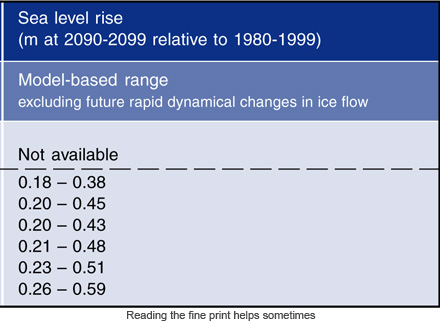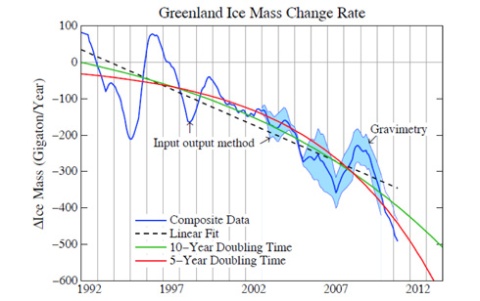Greenland: A Ring of Mountains
Posted on 4 May 2013 by greenman3610
This is a re-post from Climate Crocks.
Interviews with leading experts on Climate, Glaciers, and Greenland ice.
From the IPCC Third Assessment Report (TAR) in 2001:
The Antarctic ice sheet is likely to gain mass because of greater precipitation, while the Greenland ice sheet is likely7 to lose mass because the increase in runoff will exceed the precipitation increase.
Concerns have been expressed about the stability of the West Antarctic ice sheet because it is grounded below sea level. However, loss of grounded ice leading to substantial sea level rise from this source is now widely agreed to be very unlikely during the 21st century, although its dynamics are still inadequately understood, especially for projections on longer time-scales.
In the intervening years, more data has became available, especially gravity measurements from the GRACE satellite system. But in 2007, the 4th assessment Report (AR4) still qualified sea level rise estimates with the caveat “excluding rapid dynamical changes in ice flow” – an important point that climate deniers have deliberately chosen to ignore and exploit.
See more on this in Richard Alley’s recent lecture, which I’ll be revisiting in a future vid. Dr Alley is more concerned about West Antarctica than Greenland for the coming century. However, since 2012′s record surface melt on Greenland, and the emerging GRACE data showing Greenland with a 10 year doubling time on mass loss, there has been a renewed conversation about Greenland dynamics, and possible contributions to Sea level this century.
In a recent update, Dr. James Hansen warned specifically about change in Greenland mass loss that could lead to more rapid contributions than has been generally discussed.
Perceived authority2 in the case of ice sheets stems from ice sheet models used to simulate paleoclimate sea level change. However, paleoclimate ice sheet changes were initiated by weak climate forcings changing slowly over thousands of years, not by a forcing as large or rapid as human-made forcing this century. Moreover, in a paper submitted for publication (Hansen et al., 2013) we present evidence that even paleoclimate data do not support the degree of lethargy and hysteresis that exists in such ice sheet models.
Fig. 1 (above) shows the Greenland ice sheet mass change estimated by Shepherd et al. (2012). The input-output method calculates the difference between mass gained through snowfall and mass lost by sublimation, meltwater runoff, and discharge of ice into the ocean. This record and the analysis of satellite gravity measurements agree within their margins of error (see Shepherd et al., 2012). There are no satellite gravity data to confirm or refute the large amplitude of fluctuations prior to 2000 in Fig. 1, which are based on input-output calculations.
Fig. 1 shows that Greenland has been losing mass at a faster and faster rate over the past decade, with the recent rate corresponding to ~1 mm sea level per year (1 mm sea level = 360 Gt ice). The linear fit to the Shepherd et al. data in Fig. 1 yields a Greenland contribution to global sea level of about 30 cm by 2100.
The increasing Greenland mass loss in Fig. 1 can be fit just as well by exponentially increasing annual mass loss, a behavior that Hansen (2005, 2007) argues could occur because of multiple amplifying feedbacks as an ice sheet begins to disintegrate. A 10-year doubling time would lead to 1 meter sea level rise by 2067 and 5 meters by 2090. The dates are 2045 and 2057 for 5-year doubling time and 2055 and 2071 for a 7-year doubling time.
In light of Hansen’s calculations, the observations noted in the video, of an observed 10 year doubling by Dr. Jason Box are sobering. Dr Eric Rignot sounds a note of caution due to the magnitude of the 2012 melt, which may be an outlier. Nevertheless, Dr. Mike MacCracken, Dr. Box, and Dr. Tom Wagner have all alluded to an ongoing re-evaluation of of outlet glacier melt versus surface melt in Greenland dynamics.
For a short summary of the Sea Level kerfuffle, see my ClimateCrocks sea level vid from 2009.
This coming September, a new IPCC report will be released. A successful release will be accompanied by an intelligent social media rollout campaign to head off such obvious points of exploitation for the denialist media. More on that in coming months as well.































 Arguments
Arguments
































Interesting and disturbing, as if I could be any more disturbed ...
<pedantry>"more data has became available" should be "more data has become available"</pedantry>